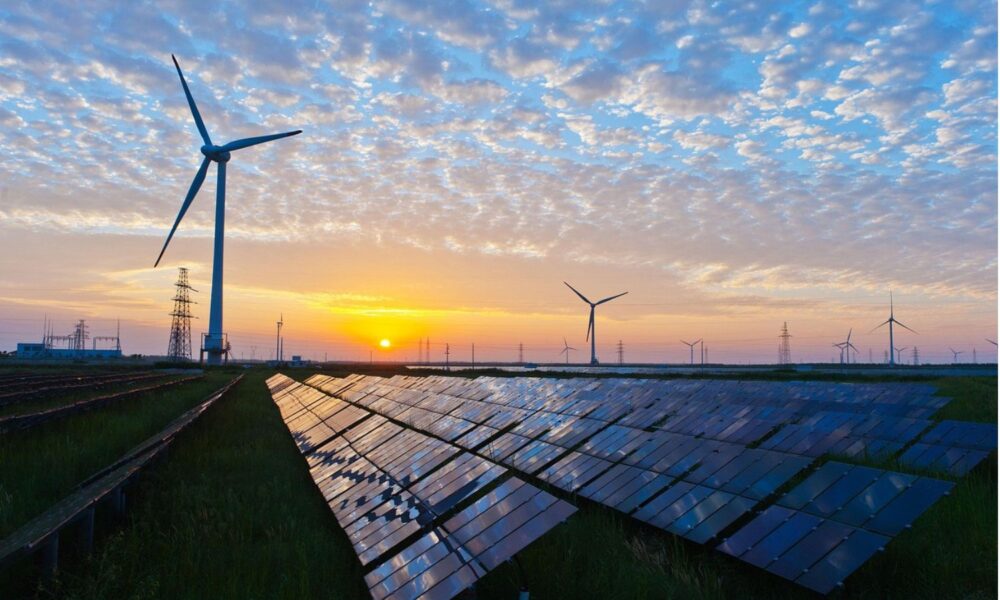Spring is a glorious time for renewable energy. Whatever the weather in March and beyond—in-like-a-lion blustery or out-like-a-lamb sunny—spring tends to be a season of strong electricity production from solar and wind in particular. Spring is also a glorious time for taking stock, since the official data on the previous year’s US electricity generation become available. And, this spring, that clean energy production is looking more impressive than ever.
A new graphic from the Union of Concerned Scientists charts the portion of electricity coming from solar and wind over time in the United States. Drawing on data from the US Energy Information Administration, it depicts solar and wind generation as a fraction of total US electricity generation, for each month over the course of more than two decades (see below).
Monthly US electricity from large-scale solar, small-scale solar, and wind divided by total monthly generation. Total generation in spring and fall is consistently lower because of lower electricity demand for heating and cooling in the shoulder seasons.
Here are some of the main takeaways I see in the hypnotically spiraling progress and the underlying data:
- In the early years, the fraction of electricity nationally from wind and solar was practically indistinguishable from zero. It didn’t pass the 1% mark on a monthly basis until 2007.
- Then came a crescendo: Solar and wind generated more than 5% of monthly electricity for the first time in 2013, passed the 10% point in 2017, and soared past 15% in 2021.
- Every month in the past two calendar years—and in 45 of the 48 months of 2020 through 2023—solar and wind supplied at least 10% of US electricity.
- Solar and wind hit their current peak on the graph in April 2023, at more than 21%. Given the recent pace of progress, though, it’s likely that they’ll break that record this spring.
Those percentages matter. Every additional 1% served by solar and wind generation means zero-carbon energy is meeting the electricity needs of the equivalent of 4 million additional US households. On an annual basis, that progress means those two technologies have gone from contributing 1 of every 23 kilowatt-hours’ worth of electricity in 2013 to 1 of every 6.4 kilowatt-hours in 2023.
What’s driving progress
If the graphic makes you think of tree rings, that’s actually a good analogy. Some years bring faster growth, some slower. And, of course, as with trees, weather matters. But in this graphic, it’s the overall trend toward increasing percentages from solar and wind that’s the most striking aspect, reflecting a number of factors.
Capacity. The biggest factor is simply the growth in the number of solar arrays and wind farms. Wind and solar have been major sources of new electric generation capacity in recent years. In 2023, for example, taken together, they accounted for two thirds of the total new megawatts installed. The United States now has more than 73,000 utility-scale wind turbines in service, 26% more than it did in 2018. Solar capacity has grown more than 160% in that time, and solar photovoltaic panels are now working away across the United States in large-scale systems, in community solar systems, and on more than four million rooftops.
Good policies at local, state, and federal levels, including renewable electricity standards and federal tax incentives, have accelerated that growth. Less-good policy decisions, as when supportive policies have expired or policy uncertainty has rattled markets, have at times slowed progress. In recent years the economics has been a key driver, as solar and wind have increasingly become the lowest-cost options for new electricity.
Generation. With all that new solar and wind capacity has come additional solar and wind generation and those numbers are equally impressive. Wind is now the leading source of renewable electricity, accounting for fully 10% of all US electricity generated in 2023. And offshore wind is increasingly looking to do its part.
Solar, meanwhile, supplied nearly 6% of the country’s electricity in 2023. That’s almost twice what it contributed five years earlier (and its annual increase in 2023 more than made up for some wind lulls last year).
Instead of despair, determination
We modeled this chart after a similar (but very different) one from the realm of climate science that presents global temperature increases over the months and years. That temperature chart conveys a decidedly less uplifting message, depicting the dangerous trend toward higher and higher temperatures.
Perhaps this new chart can serve as a partial counterbalance. Not to take the pressure off ourselves; there’s plenty to be worried about when it comes to global warming, and much we still need to do. But there’s also a lot we can do, and this graphic should help to help make clear that, while climate change is serious, we are mounting serious responses too.
So, this spring, enjoy sunshine and the wind as heralds of the new season. But also appreciate their power to make a real difference at cleaning up our energy use and helping our economy and the planet—as well as recognizing that there’s a lot more to come. Let’s keep that spiral growing.

